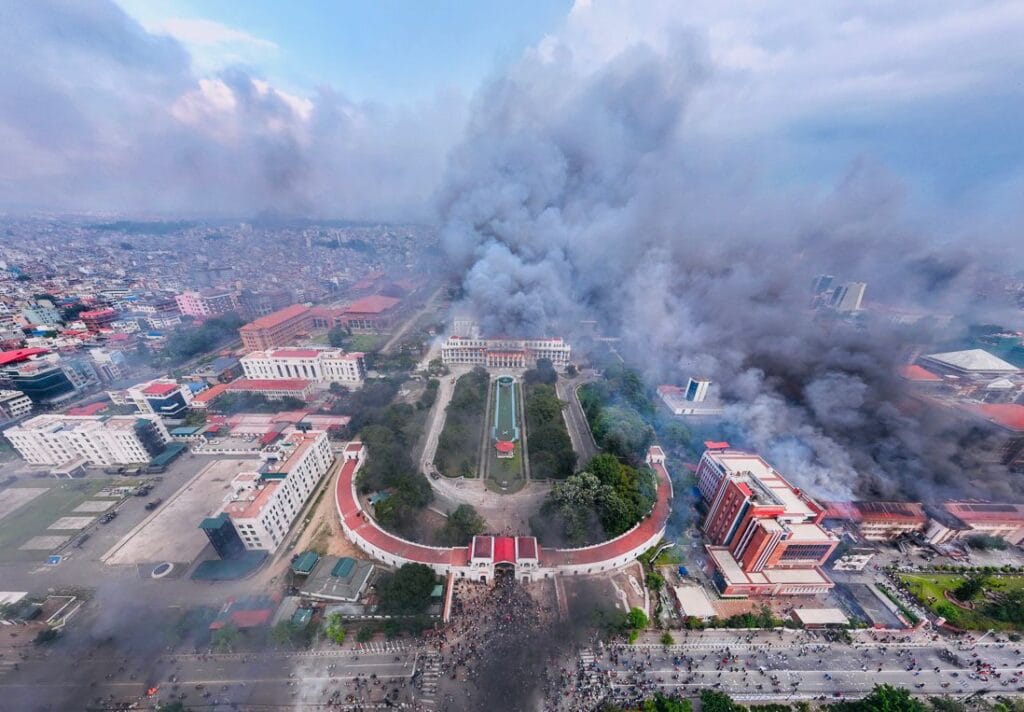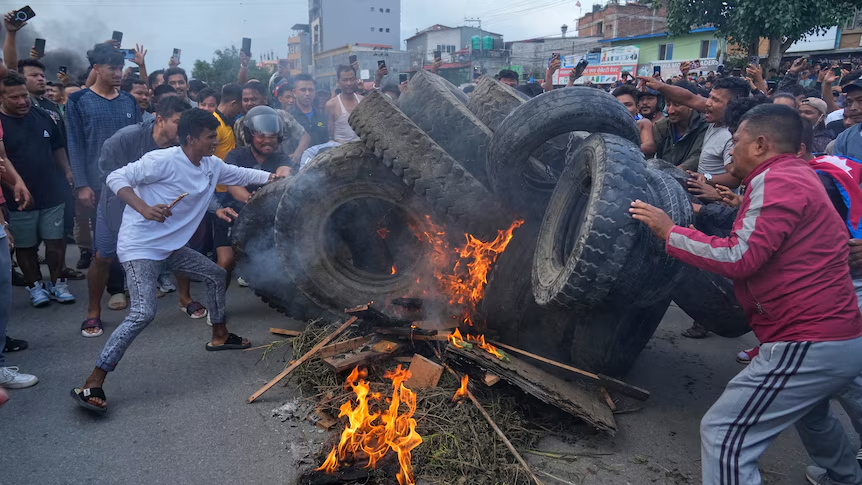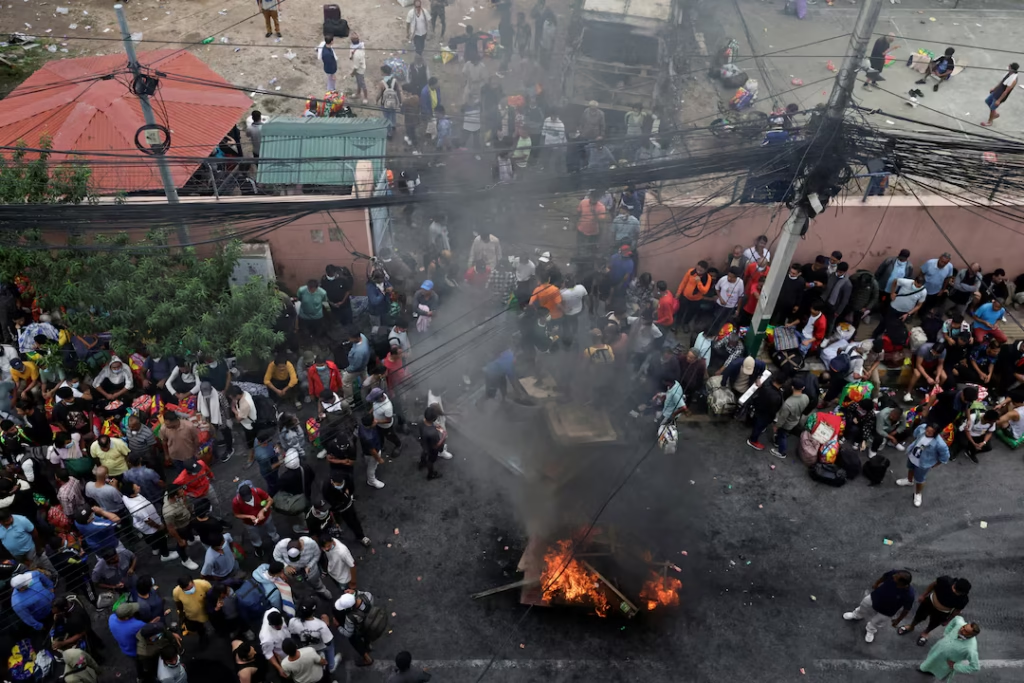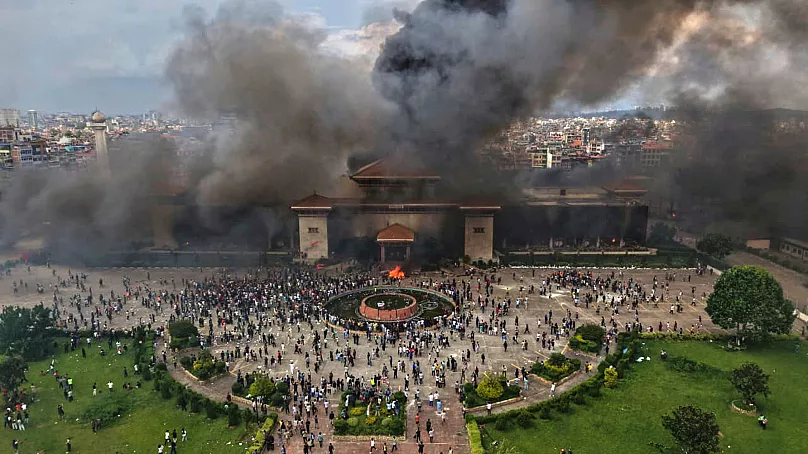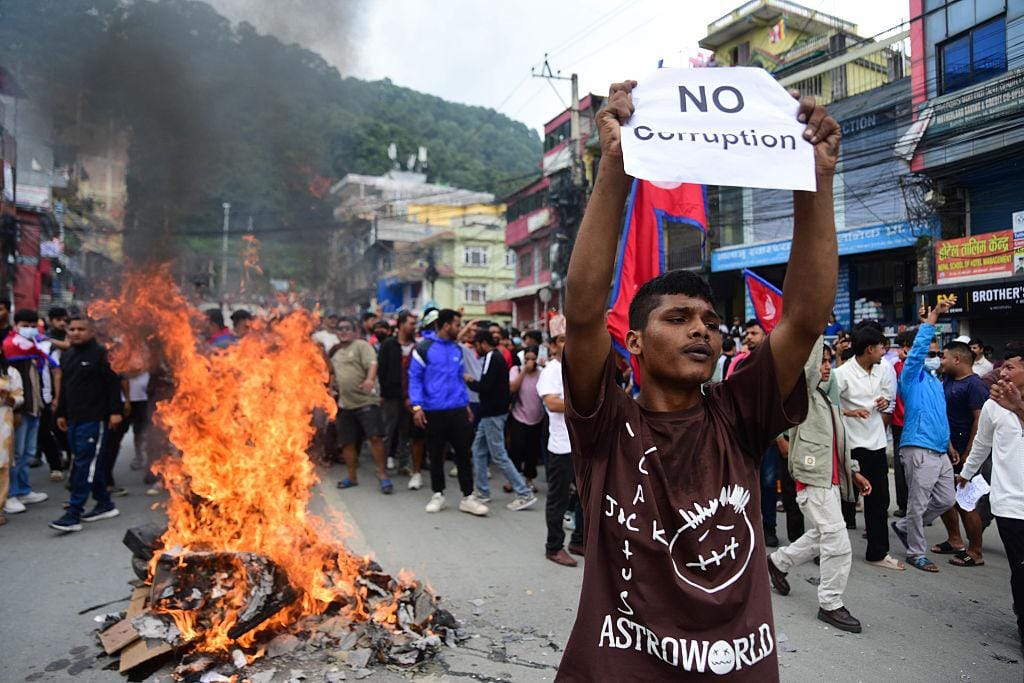Highlights
- Ban sparks revolt — A sweeping social media blackout ignites the Gen Z protest in Nepal.
- Blood on the streets — At least 19 youths killed, 100+ injured in one day.
- Nation in flames — Parliament, courts, party HQs, media houses, and even supermarkets torched.
- Oli toppled — PM K.P. Oli resigns as his home and office burn.
- Gen Z’s demand — Jobs, dignity, and freedom of expression, Nepal—not exile or silence.
At Volunteers Initiative Nepal (ViN), we believe informed action is the path to change. Apply to volunteer, donate, or partner with us to help Nepal rebuild stronger and fairer.
A capital under curfew
By dawn on September 10, Kathmandu resembled a city under siege. Curfew in Kathmandu meant shuttered shops, empty roads, and soldiers stationed outside landmarks where crowds had raged just 24 hours earlier. Armoured trucks guarded Parliament, their tyres blackened with soot from the fire that tore through its façade the night before. Airlines suspended and then staggered flights as smoke plumes and barricades disrupted movement (Reuters, 2025).
What began as a Gen Z protest in Nepal over online freedoms had exploded into Nepal’s largest uprising in decades. By the end of 48 hours, at least 19 protesters were dead, hundreds were wounded, and Prime Minister K.P. Sharma Oli resigned (The Guardian, 2025). The Gen Z uprising in Nepal showed how quickly a state can unravel when youthful frustration meets brittle institutions.
The spark: a 26-platform ban
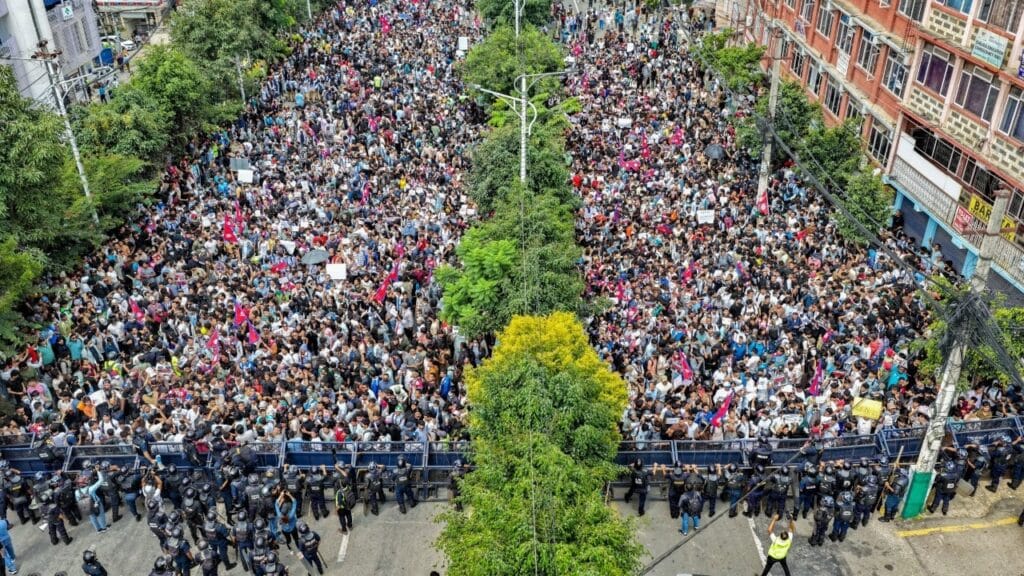
On September 8, Nepal’s government abruptly ordered a Nepal social media ban 2025, cutting off access to 26 platforms, including Facebook, TikTok, Instagram, YouTube, WhatsApp, and LinkedIn (Al Jazeera, 2025). Officials framed it as a regulatory step to force companies to register locally. Critics and protesters called it online censorship in Nepal.
The Nepal internet shutdown was short-lived—lifted the following day after backlash—but it had already lit the fuse. “You can silence the apps, not the people,” said Anisha Shrestha, a 20-year-old protester quoted by Ratopati. Downloads of VPN Nepal tools surged overnight as students routed around the block.
International media quickly asked: Why did Nepal ban social media at all? Analysts pointed to the government’s growing use of emergency powers in Nepal, coupled with fear of dissent. Instead of controlling the narrative, the ban mobilized a generation already cynical about corruption and lack of opportunity.
September 8: The day 19 died
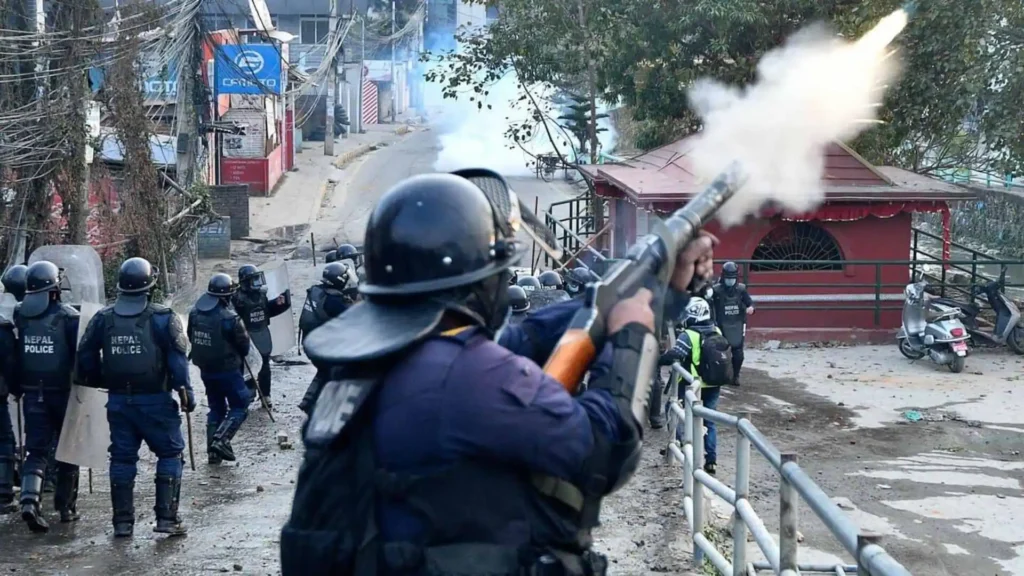
That Monday, thousands marched from Maitighar to New Baneshwor, converging at the gates of Parliament. What began as chanting—“Give us freedom, not bans”—soon met the full force of police. Tear gas shells burst, water cannons swept crowds, and rubber bullets flew. Witnesses and hospital officials reported live ammunition, too (AP, 2025).
By evening, hospitals confirmed at least 19 Nepal protest deaths, most of them under 25, with more than 100 wounded (Reuters, 2025)—images of bloodied students carried on stretchers spread across international media. The Home Minister, Ramesh Lekhak, resigned in shame that night (myRepublica, 2025).
The government hurriedly rescinded the ban, but it was too late. Anger had spilled from the digital blackout into the streets. As one TIME magazine analyst put it, “the apps were the spark; decades of frustration were the fire.”
September 9: Fire and fury
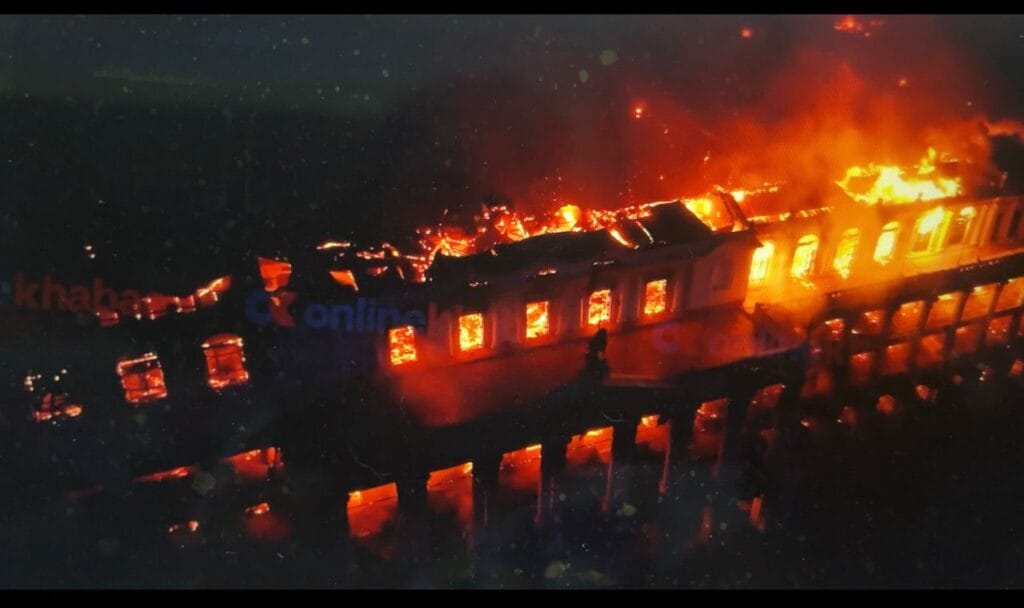
If September 8 was about blood, September 9 was about flames. Crowds torched symbols of state authority and political privilege. The list of damage read like a map of the republic:
- Federal Parliament in New Baneshwor, partially burned.
- Singha Durbar complex, the seat of government, gutted by fire.
- Prime Minister’s official residence in Baluwatar and his private home in Balkot were set ablaze.
- President’s Office (Sheetal Niwas), torched in Maharajgunj.
- Supreme Court, Special Court, and Kathmandu District Court, all set alight.
- Party headquarters of the Nepali Congress (Sanepa), CPN-UML (Chyasal), and Janata Samajbadi Party (Chyasal).
- Private residences of former PM Sher Bahadur Deuba, NC General Secretary Gagan Thapa, Maoist leader Pushpa Kamal Dahal “Prachanda,” and President Ram Chandra Paudel, all attacked or burned.
- Media outlets: Kantipur Media Group HQ and Annapurna Post offices, targeted and damaged, raising alarms from the Committee to Protect Journalists.
- Commercial landmarks: Bhat-Bhateni Supermarket (Naxal) and the Hilton Kathmandu Hotel, both charred.
- Police assets: vehicles at the Traffic Police Headquarters were destroyed.
“The destruction of state and private property was unprecedented,” wrote The Himalayan Times (2025). The Guardian framed it bluntly: “Nepal has seen its worst unrest in decades.”
That evening, under mounting chaos, KP Oli’s resignation was announced. He was evacuated under army protection, his resignation confirming what protesters had already forced on the streets.
September 9–10: Jailbreaks, raids, and rumours
As the flames consumed government buildings, another crisis unfolded: jailbreaks. By late evening on September 9, local police in Pokhara confirmed that at least 773 inmates had escaped from Kaski prison, with guards overwhelmed (Asia Media Centre, 2025). Hours later, reports from Tulsipur in western Nepal cited another 127 prisoners freed after rioters stormed the compound (Dhaka Tribune, 2025).
Numbers spread quickly online—some claiming “thousands escaped nationwide”—but wires urged caution. Verified tallies were district-specific, and officials themselves admitted they had lost track. For many, the image of padlocks broken and prisoners vanishing into the night symbolized how the state’s grip had loosened.
By the morning of September 10, army units had secured central prisons in Kathmandu and Bhaktapur, seeking to prevent further breakouts. Officials hinted that some of the escaped inmates had blended into crowds, complicating already blurred lines between peaceful Gen Z protest Nepal and opportunistic criminality.
September 10: Armed calm
By Wednesday, the capital wore the look of a city under emergency powers in Nepal. Soldiers with rifles guarded the gates of Parliament. Streets were deserted under curfew Kathmandu, while checkpoints sprang up across Ring Road. Shops remained shuttered, schools closed, and journalists reported a heavy army presence near the charred Singha Durbar complex.
Airlines, including IndiGo, cautiously resumed flights after suspending them the previous day, though the airport remained under tight security (Economic Times, 2025). The army warned it would deal “decisively” with vandalism, looting, or arson. Dozens of youths were arrested on suspicion of looting supermarkets and torching vehicles.
However, the Gen Z uprising in Nepal had not disappeared. “You can patrol the streets,” said 21-year-old protester Milan Tamang to Setopati, “but you cannot patrol our anger.”
Roots of rage: jobs, dignity, and freedom
Analysts agree the Nepal social media ban 2025 was only the spark. The fire was decades in the making. Youth unemployment remains above 20%, according to World Bank estimates (2024). Hundreds of thousands of Nepali youths migrate annually for work or study abroad, often in low-paid, high-risk jobs. Corruption scandals and “nepo kids”—the children of politicians filling lucrative posts—fuelled disillusionment (Reuters, 2025).
Above all, digital natives saw the ban as a direct assault on freedom of expression in Nepal. Overnight, hashtags turned into banners. Viral Gen Z slogans Nepal like “We do not want jobs abroad, we want dignity at home” and “Shut down corruption, not the internet” appeared on placards and TikTok before being chanted in the streets.
This was more than protest. It was Gen Z protest symbolism: memes transformed into chants, VPN log-ins into civil disobedience, and smartphone-native humour into revolutionary language. TIME magazine noted that “for Nepal’s Gen Z, losing social media felt like losing a limb” (TIME, 2025).
Protest vs. riot: lines blurred
Rights groups were quick to condemn the killings of September 8. Amnesty International called for an independent inquiry into Nepal protest deaths, stressing the state’s duty to avoid lethal force. At the same time, civil society leaders distanced themselves from the destruction of September 9.
“There is a difference between protest and arson,” lawyer Anupama Koirala told The Guardian. “Burning the Supreme Court is not justice. It is rage without focus.”
The Committee to Protect Journalists condemned the torching of Kantipur Media Group and Annapurna Post, calling it “a direct attack on press freedom in a fragile democracy.”
For ordinary citizens, the distinction mattered. “I marched on Monday for dignity,” said shopkeeper Laxmi Gurung. “But on Tuesday, I saw my shop looted. That was not dignity—it was theft.”
Institutions on the edge: collapse or resilience?
By September 10, the list of destroyed landmarks was staggering. Federal Parliament, the Singha Durbar government complex, the Supreme Court, and Kathmandu District Court—all bore the marks of fire. Party headquarters for both ruling and opposition groups were ransacked. Private residences of Nepal’s most powerful leaders, from Sher Bahadur Deuba to Prachanda, were torched. Even the Hilton Kathmandu and Bhat-Bhateni supermarket chains were reduced to blackened shells.
The attacks carried deep symbolism. Protesters were not just venting anger—they were targeting the architecture of authority itself. However, rumours spread faster than verified news. Social media posts claimed “all data centers collapsed” and “the judiciary is gone.” International wires pushed back. As Reuters noted, “service disruptions were real and evolving, but no nationwide IT collapse has been confirmed.”
This distinction matters. The Gen Z protest in Nepal damaged symbols of governance, but the system has not evaporated. Judges, civil servants, and journalists continue their work under duress. Institutions bend; whether they break is the question.
After Oli: vacuum or opening?
The resignation of K.P. Sharma Oli was the uprising’s most tangible political victory. Announced late on September 9, it followed the burning of his official residence and the storming of his party’s headquarters. International media described it as the inevitable outcome of lost legitimacy. The Guardian called it “a collapse accelerated by bloodshed.”
However, what comes after KP Oli’s resignation remains unsettled. Analysts point to three scenarios:
- A caretaker government drawn from opposition parties.
- A coalition reshuffle that reintroduces familiar faces.
- An interim body with Gen Z inclusion, a demand voiced by Energy Minister Kulman Ghising and echoed on social media (OnlineKhabar, 2025).
“Youth removed a prime minister in 48 hours,” said political analyst Prakash Rai. “If they are excluded from what comes next, the cycle will repeat.”
What to watch in the next 72 hours
- Curfew Kathmandu — will it tighten or ease? The army has signalled willingness to extend restrictions indefinitely.
- Nepal protest deaths inquiry — will the government launch an independent probe, as urged by Amnesty International and the UN?
- Airport and economy — can flights, trade, and banking resume under military watch?
- Dialogue — will interim leaders invite youth voices, or treat the Gen Z uprising in Nepal as disorder to be contained?
- Misinformation — will authorities publish timestamped tallies of jailbreaks, arrests, and damages, or allow rumour to drive the narrative?
The coming days will determine if this becomes a turning point toward reform—or a prelude to deeper unrest.
Factbox: What exactly was banned?
On September 8, Nepal’s government blocked access to 26 platforms: Facebook, Instagram, TikTok, YouTube, WhatsApp, X (formerly Twitter), Snapchat, LinkedIn, and others. Officials justified it as “registration compliance.” Youth labeled it an internet blackout in Nepal. VPN downloads spiked overnight, with many students proudly posting, “We are still online.”
The ban was lifted on September 9, but its political cost had already spiralled out of control.
Human stories behind the numbers
- Bhumika, 19, carried a banner reading “Freedom is not a crime.” Her cousin was killed on September 8.
- Ravi, 24, recently returned from Qatar, joined protests: “I do not want to die abroad building someone else’s dream.”
- Laxmi, 45, whose grocery shop was looted: “I do not blame the kids. I blame the leaders who ignored them.”
These stories illustrate why the uprising resonated with people. It was not just about apps—it was about dignity, belonging, and the right to a future at home.
The kicker: a blank feed in a burning city
On the evening of September 10, a lone student stood outside a shuttered teahouse near Maitighar. Soldiers manned the intersection, rifles slung. He unlocked his phone. The apps were back online, but his screen showed a blank notification bar.
In three days, Nepal went from Nepal social media ban 2025 to fires in Parliament, from Gen Z protest symbolism on placards to the KP Oli resignation. What comes next will depend on whether leaders treat the Gen Z uprising in Nepal as a warning shot—or a wasted chance.
Nepal stands at a crossroads—not just between turmoil and stability, but between despair and the possibility of a new beginning. Together, we can help transform this reckoning into the foundation of peaceful, prosperous, equitable, and truly happy societies in Nepal.
Join Volunteers Initiative Nepal (ViN) in this mission:
👉 Apply to Volunteer — Lend your skills, passion, and time to empower communities on the ground. Every hour you give lights a path toward dignity and opportunity.
👉 Donate Now — Your contribution fuels education, women’s empowerment, health, and resilience. Even a small gift can create ripples of lasting change.
👉 Partner With Us — Join hands as an ally. Whether you are an institution, business, or network, your partnership can amplify impact and help transform Nepal’s future Your action today plants the seed of dignity, accountability, and lasting hope for tomorrow.

